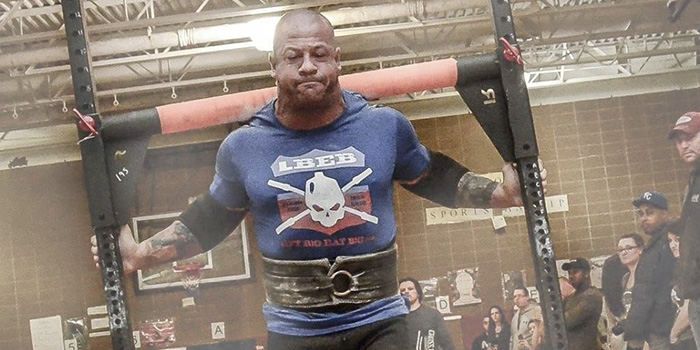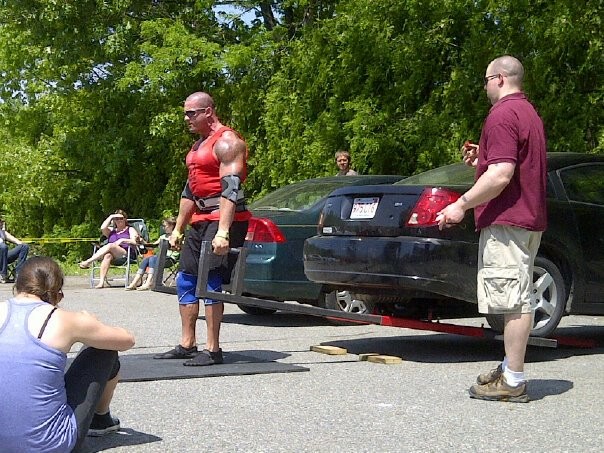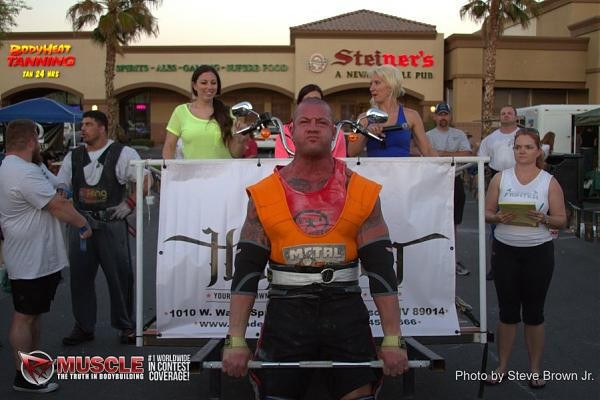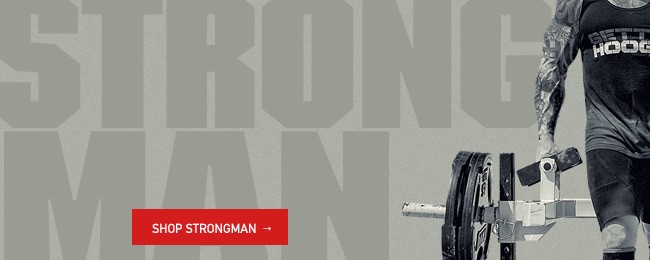
Training for strongman can be very complicated. Every competition is different, and many times the events and weights are even changed last minute. You truly have to be prepared for anything when it comes to the sport, and that’s what I love about it. The sport requires a combination of strength, power, speed, and even endurance. To make it to the pro level you need to have all of these skills, with very few weak points. Unfortunately, many competitors only focus on their strengths, never making it to the next level because of it. There will always be moving events in strongman, so conditioning is a must to move weights quickly. However, when it comes to the overhead press and the deadlift, we see the most variability from contest to contest. A max event will require slightly different training then an event of extreme high reps.
RECENT: Training the Strongman Yoke
Generally you will know what weight you will be training for when it comes to the deadlift in strongman. Whether it’s from the floor or an 18-inch silver dollar, deadlift training for a max pull or for reps should be straightforward. When it comes to the car deadlift, however, you can never know what to expect. I have competed with the car deadlift where I had to pull over 20 reps, and other times only two or three reps were needed for the win. Every time on the car, we had no idea what to expect. The deadlift program I’m going to outline will prepare you for both a heavy event and a high rep event. This will be perfect for those in strongman that are not given events for a specific contest (which happens quite a bit at the higher level).
I like to combine both ways of training to build not only strength but also conditioning for the exercise. Start by choosing a rep scheme in the strength range — let’s say a heavy set of three reps is the goal for the day. Once you achieve this weight you will then drop down to 65% or 70% of this weight to perform “speed reps.” For example, if you deadlifted 500 for three reps you will then drop to 340 pounds. This is where you will be getting your volume work in, so now perform six sets of four reps. Each rep will be as fast as possible, and here comes the tough part: we are trying to build conditioning at the same time, so the rest period will only be one minute. While keeping the rest periods short we will also be working on building muscle as well. For the four-week mini cycle, your goal each week is to slightly increase your heavy triple and then add two more speed sets until you reach the third week. The fourth week will be a much-needed deload.
Starting with 500 pounds on the deadlift, the program will look like this:
Week 1:
- Deadlift — 500 x 3 reps
- Speed Deadlift — 340 x 4 reps x 6 sets (60 seconds rest)
Week 2:
- Deadlift — 510 x 3 reps
- Speed Deadlift — 340 x 4 reps x 8 sets (60 seconds rest)
Week 3:
- Deadlift — 515 x 3
- Speed Deadlift — 340 x 4 reps x 10 sets
Week 4:
- Deload
This will be a great way to get ready for an event that you know will be higher repetitions. By the third week you will be performing 40 reps in a very short amount of time, so you will be building great endurance to go 20 or more reps when it comes time to compete.
Now let’s look at a last man standing event, which is a crowd favorite at any show. In a last man standing event, there is a set weight to begin with that every competitor must do to move on. Every round the weight increases a certain amount until there is only one competitor left. Most people train this event just trying to increase their one-rep max, but with this event, you are most likely performing a lot of reps until you even come close to what that weight might be. When it comes time for the event, many competitors are not prepared for the high volume and they fall short long before their actual one-rep max. Also, once competitors start dropping out, your rest time between lifts will also drop making this event even more difficult.
Again, training economy must be built to withstand the volume of this event while also increasing your one-rep max, so the answer again is to deadlift more. We are going to take a slightly different approach this time, but with the same general setup. Since you will only be performing one rep at a time, the goal each week will be to reach a heavy single, but you are not going to grind out a max rep until the third week. This is very important to follow, as you are not building strength by grinding out heavy singles every week. Like I said before, you will only stall out fast if you try to. Also, just to be clear, I am using the example of the deadlift but this setup can be used for any lift you would like to increase.
For the first week, set a goal for yourself to work up to a heavy single but not a new PR just yet. You should leave a little in the tank so you know you can increase it next week. Let’s say you get up to 600 pounds on the deadlift. For your speed reps you will now be working at 75%, so the weight is 450 pounds with 90 seconds of rest.

Now, instead of increasing the number of sets like last time we will increase the weight each week, as that is the main goal of this event.
Week 1:
- Deadlift — 600 x 1 rep
- Speed Deadlift — 450 x 2 reps x 6 sets (90 seconds rest)
Week 2:
- Deadlift — 610 x 1 rep
- Speed Deadlift — 465 x 2 reps x 6 sets (90 seconds rest)
Week 3:
- Deadlift — 620 x 1 rep (PR week)
- Speed Deadlift — 475 x 2 reps x 6 sets (90 seconds rest)
Week 4:
- Deload
Using either of these programs will prepare you for any event you are training for. These mini cycles can be repeated for as long as they continue to work for you. Start each cycle with your new max and use the given percentages to continue both increasing your weight and training volume.
Following deadlifts, I like to train stones (or whatever the loading event may be, like a keg load for example). Your back will definitely be tired at this point, but the day of the contest you will be hitting these events back-to-back, so you need to be conditioned for a long day. I’ve seen too many competitors fall apart by the last event from being smoked from the previous events. I like to keep my training to two events in a day followed by accessory work. Here’s an example of what a deadlift and event day could look like:
1. Deadlift — Weekly protocol (listed above)
2. Speed Deadlift — Weekly protocol (listed above)
3. Stone Series — Work up to two runs at contest weight
4. Chest Supported Row — 4 x 10
5a. Banded Hamstring Curls — 3 x 20
5b. Ab Wheel — 3 x 12











